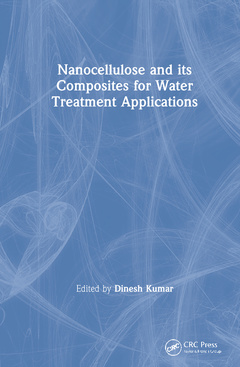Nanocellulose and Its Composites for Water Treatment Applications
Coordonnateur : Kumar Dinesh

Biological materials and their applications have drawn increasing attention among scientists. Cellulose is an abundant, renewable, biodegradable, economical, thermally stable, and light material, and it has found application in pharmaceuticals, coatings, food, textiles, laminates, sensors, actuators, flexible electronics, and flexible displays. Its nano form has extraordinary surface properties, such as higher surface area than cellulose; hence, nanocellulose can be used as a substitute for cellulose. Among many other sustainable, functional nanomaterials, nanocellulose is attracting growing interest in environmental remediation technologies because of its many unique properties and functionalities.
Nanocellulose and Its Composites for Water Treatment Applications supplies insight into the application of nanocellulose and its nanocomposites for water purification and remediation. It covers different classes of nanocellulose?cellulose nanocrystal (CNC), microfibrillated cellulose (MFC), hairy cellulose nanocrystalloid (HCNC), and bacterial nanocellulose (BNC)?for their competency with other renewable and carbonaceous materials such as pectin, alginate, and CNTs. Future perspectives of nanocellulose and nanocomposites gleaned from different biodegradable origins are also discussed.
This book delves into an updated description of the basic principles and developments in synthesis, characterization methods, properties (chemical, thermal, optical, structural, surface, and mechanical structure), property relationships, crystallization behavior, and degradability of biodegradable nanocomposites. The book also supplies vivid information about various cellulose nanomaterials and their applications in absorbing organic and inorganic toxins, membrane filtration of bacteria, viruses, and ionic impurities, photocatalytic dye removal, and sensing of water toxins.
Features
- Details the synthesis and characterization methods of nanocellulose
- Illustrates the applications of nanocellulose and its nanocomposites
- Shows in-depth accounts of the various types of properties of nanocellulose and its composites
- Features emerging trends in the use of nanocellulose as adsorbents, sensors, membranes, and photocatalysis materials
This book will be useful for academics, researchers, and engineers working in water treatment and purification.
Dinesh Kumar is currently working as Professor in the School of Chemical Sciences at the Central University of Gujarat, Gandhinagar, India. Prof. Kumar obtained his master's and Ph.D. degrees in Chemistry from the Department of Chemistry, University of Rajasthan, Jaipur in 2002 and 2006, respectively. Prof. Kumar has received many national and international awards and fellowships. His research interest focuses on the development of capped MNPs, core-shell NPs, and biopolymers incorporated metal oxide-based nanoadsorbents and nanosensors for the removal and the sensing of health hazardous inorganic toxicants like fluoride and heavy metal ions from aqueous media. Prof. Kumar developed hybrid nanomaterials from different biopolymers like pectin, chitin, cellulose and chitosan for water purification. His research interests also focus on the synthesis of supramolecular metal complexes, metal chelates their biological effectiveness. He has authored and co-authored over 90 publications in journals of international repute, one book, over seven dozen book chapters, and 70 presentations/talks at national/international conferences
Date de parution : 07-2021
17.8x25.4 cm
Thèmes de Nanocellulose and Its Composites for Water Treatment... :
Mots-clés :
BNC; CNCs; CNFs; Cellulose Nanowhiskers; Go; Cellulose Nanomaterials; Cellulose Microfibril; NC Material; Adsorption Capacity; AFM; Pah; Bacterial Cellulose; Nanocrystalline Cellulose; Congo Red Dye; Water Flux; Cellulose Fibers; Heavy Metal Adsorbent Capacity; Nanocomposite Membrane; Consecutive Adsorption Desorption Cycles; Conductometric Titration; SEM; Malaviya National Institute; Water Purification Applications; American Chemical Society; Cellulose II



